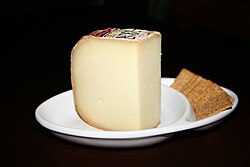
Roquefort is a sheep milk blue cheese from southern France. Though similar cheeses are produced elsewhere, EU law dictates that only those cheeses aged in the natural Combalou caves of Roquefort-sur-Soulzon may bear the name Roquefort, as it is a recognised geographical indication, and has a protected designation of origin.
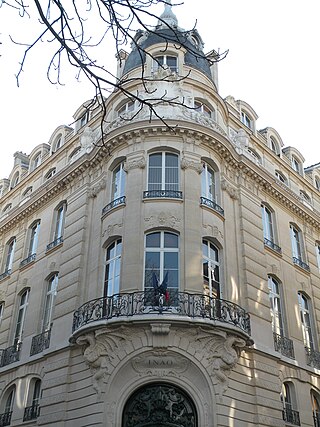
In France, the appellation d'origine contrôlée (AOC) is a label that identifies an agricultural product whose stages of production and processing are carried out in a defined geographical area – the terroir – and using recognized and traditional know-how. The specificity of an AOC product is determined by the combination of a physical and biological environment with established production techniques transmitted within a human community. Together, these give the product its distinctive qualities.

Cantal cheese is an uncooked firm cheese produced in the Auvergne region of central France: more particularly in the département of Cantal as well as in certain adjoining districts. Cantal cheese was granted Appellation d'Origine Contrôlée certification in 1956. One of the oldest cheeses in France, Cantal dates back to the times of the Gauls. It came to prominence when Marshal Henri de La Ferté-Senneterre served it at the table of Louis XIV of France. Senneterre is also responsible for the introduction of Saint-Nectaire and Salers.

Beaufort is a firm, raw cow's milk cheese associated with the gruyère family. An Alpine cheese, it is produced in Beaufortain, Tarentaise valley and Maurienne, which are located in the Savoie region of the French Alps.

The Institut national de l'origine et de la qualité (INAO) is the French organization charged with regulating French agricultural products with protected designation of origin (PDOs). Controlled by the French government, it forms part of the Ministry of Agriculture. The organization was co-founded by Châteauneuf-du-Pape producer Baron Pierre Le Roy.

Abbaye de Belloc is a French Pyrenees semi-hard cheese from the Pays Basque region, made from unpasteurized sheep milk.

Pont-l'Évêque is a French cheese, originally manufactured in the area around the commune of Pont-l'Évêque, between Deauville and Lisieux in the Calvados département of Normandy. It is probably the oldest Norman cheese still in production.
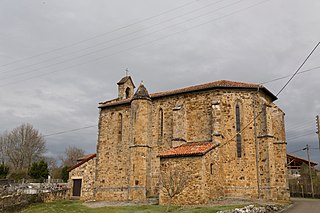
Arancou is a commune in the Pyrénées-Atlantiques department in southwestern France.

Époisses, also known as Époisses de Bourgogne, is a legally demarcated cheese made in the village of Époisses and its environs, in the département of Côte-d'Or, about halfway between Dijon and Auxerre, in the former duchy of Burgundy, France, from agricultural processes and resources traditionally found in that region.
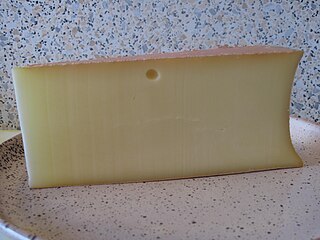
Abondance is a semi-hard, fragrant, raw-milk cheese made in the Haute-Savoie department of France. Its name comes from a small commune also called Abondance. A round of Abondance weighs approximately 10 kg (22 lb), and its aroma is comparable to Beaufort, another French cheese variety. Abondance is made exclusively from milk produced by the Abondance, montbéliarde, and tarine breeds of cattle. By 2022, the herd producing the milk for Abondance cheese will need to be a minimum of 55 percent of the herd. In 1998, 873 tonnes were produced, 34 percent from local farms.

Laguiole, sometimes called Tome de Laguiole, is a pressed uncooked French cheese from the plateau of Aubrac, situated at between 800 - 1400m, in the region of Aveyron in the southern part of France. It takes its name from the small town of Laguiole and has been protected under the French Appellation d'Origine Contrôlée (AOC) since 1961 and a Appellation d'origine protégée since 1996. Laguiole is said to have been invented at a monastery in the mountains of Aubrac in the 19th century. According to historical accounts, the monks passed down the recipe for making this cheese from cattle during the alpages to the local buronniers, the owners of burons, or mountain huts.
Saussignac is a wine appellation in South West France. The Saussignac AOC is used exclusively for a sweet white dessert wine, similar to Monbazillac but a little drier. The grapes used are generally Sémillon grapes which have been affected by Botrytis cinerea. To qualify for the appellation, the grapes must be grown, and the wine produced, in the four communes of Saussignac, Razac-de-Saussignac, Monestier and Gageac-et-Rouillac. A fundamental difference between Saussignac and all other sweet or late-harvest wines is that chaptalization, or the addition of sugar, is forbidden under the rules of the AOC.
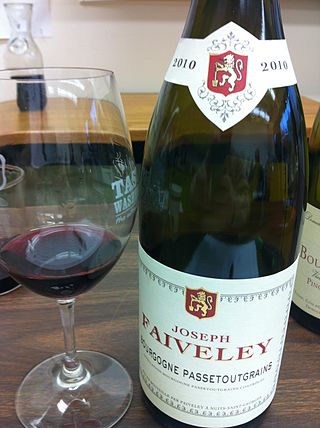
Bourgogne Passe-Tout-Grains is an Appellation d'origine contrôlée (AOC) for wine from the region of Burgundy in France. Most Bourgogne Passe-Tout-Grains, which is sometimes written unhyphenated as Bourgogne Passetoutgrains, is red although rosé wine may also be produced. Unlike other Burgundy wines, which are primarily produced from a single grape variety, Bourgogne Passe-Tout-Grains is essentially a cuvée of Gamay and Pinot noir.

Aste-Béon is a commune in the Pyrénées-Atlantiques department in the Nouvelle-Aquitaine region of south-western France.

Fourme de Montbrison is a cow's-milk cheese made in the regions of Rhône-Alpes and Auvergne in southern France. It derives its name from the town of Montbrison in the Loire department.

Saint-Faust is a commune in the Pyrénées-Atlantiques department in south-western France.

Caladoc is a red French wine grape variety planted primarily in the southern wine regions such as the Languedoc. The grape is a crossing of Grenache and Malbec created by Paul Truel in 1958 at Institut National de la Recherche Agronomique (INRA).
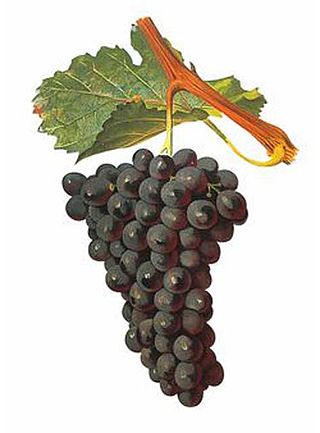
Terret is an ancient Vitis vinifera vine that, like the parent Pinot vine of Pinot noir's history, mutated over the course of thousands of years into grape varieties of several color. Originating in the Languedoc-Roussillon wine of southern France, the descendants of Terret now include the red wine variety Terret noir, the white Terret blanc and the light-skinned Terret gris.
Brousse du Rove is a type of goat milk cheese, made in the commune of Le Rove in the Bouches-du-Rhône region of France.
